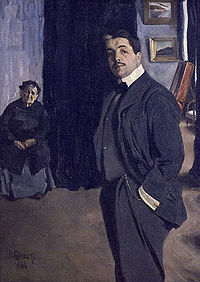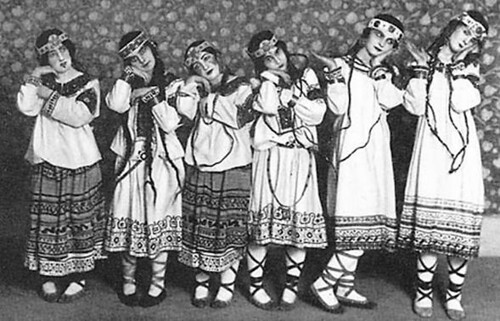As defining moments go, 29 May 1913 is more famous in the history of the Ballets Russes than December 1910. That was the date of the first performance of Igor Stravinsky's Rite of Spring at the Théâtre du Champs-Elysée in Paris; and it was an occasion that saw riots amongst the first audience, requiring police intervention.
Critics are divided as to whether the audience was upset most by the polytonal asymmetrical rhythms of Stravinsky's music, by the Fauvist costumes and set designs of Nicholas Roerich, by the unorthodox choreography devised by the Ballet Russes star dancer Vaslav Nijinsky (dancers shuffled on with pigeon-toed movements), or by the subject matter of the ballet itself: a young pagan girl is chosen by her tribe as a sacrifice and dances herself to death, to the orgiastic accompaniment of Stravinsky's rhythmic chords.
The BBC's recent drama, 'Riot at the Rite' neatly captures the aura of controversy surrounding the Rite, from the personal tensions between the artists involved to the behaviour of the audience.
It also rightly identifies the central role of Sergei Diaghilev, the director of the Ballet Russes. Diaghilev is an unusual figure in the history of ballet: after a failed attempt to become a composer, he made a name for himself in Russia, through editing an avant-garde arts magazine, Mir iskusstva, but came to prominence in the West through a series of art exhibitions, promoting Russian painting in Paris during the early years of the Twentieth Century.
 |
| Diaghilev, by Léon Bakst (1906) |
Ballet, even more so than other theatrical art forms, is supremely collaborative. It depends on the combined talents of choreographers, dancers, musicians, designers and composers for the creation of spectacle. The V&A conveys this through the sheer variety of media on display in the exhibition: dancing shoes, costumes and musical scores vie with video projections of archive performances and the rooms are dotted with small booths playing an excellent series of informative films by Howard Goodall about the musical background to Diaghilev's ballets. In fact, the only problem with the exhibition is that there is so much multimedia on display that it is sometimes difficult to make out what Goodall is saying over the sound of Stravinsky's Firebird in another part of the room.
 |
| Stravinsky in 1910 |
It may, then, be a mug's game to try and pin down particular transformative moments in cultural history, but the first performance of the Rite of Spring certainly made a commotion. Diaghilev’s response? ‘Exactly what I wanted’.


No comments:
Post a Comment